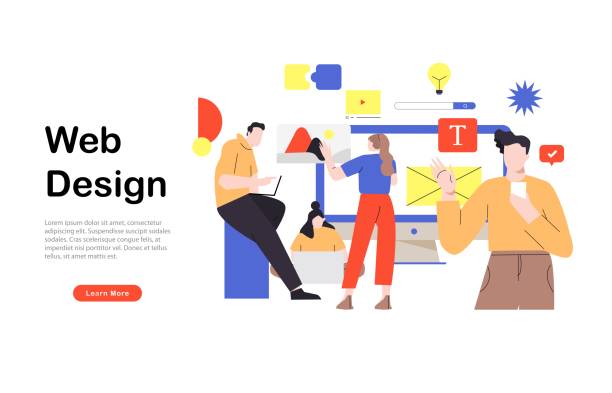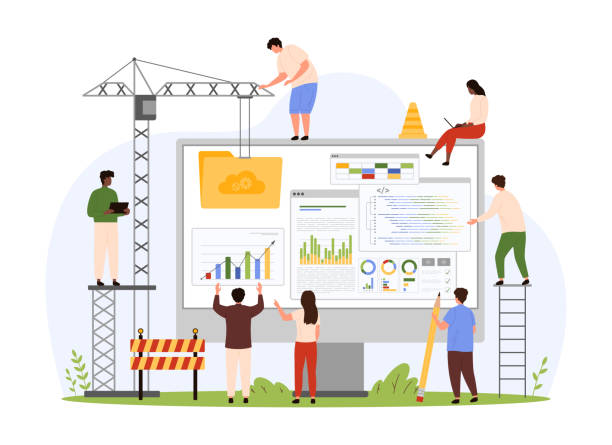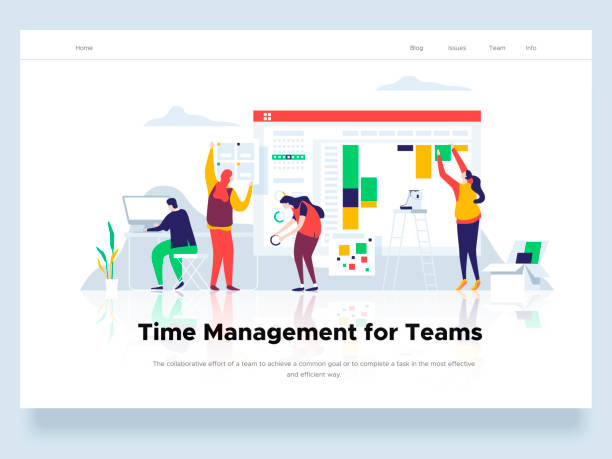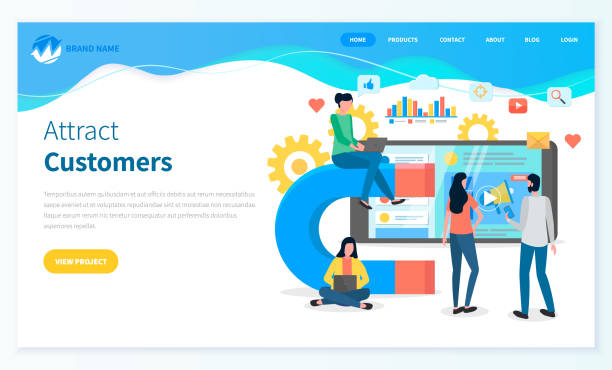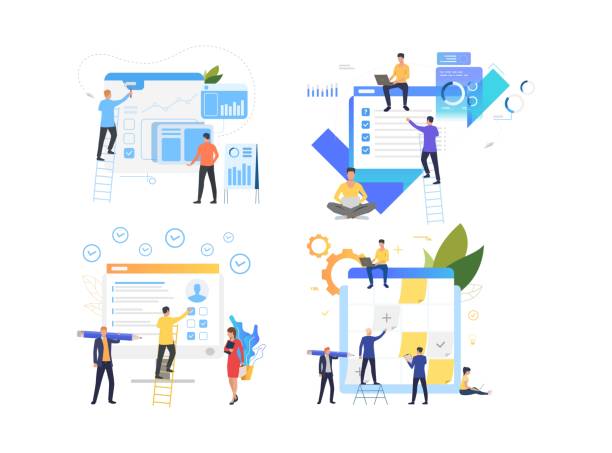Introduction and Why E-commerce Website Design is Important?
In today’s world, where geographical boundaries hold no meaning for #eCommerce, #websiteDesign for an online store is no longer an option, but a necessity for the survival and growth of any business.
From small home-based businesses to large international brands, all are seeking to expand #onlineSales and strengthen their #digitalPresence.
But why is designing an e-commerce website so important? The answer lies in broad accessibility, reduced costs, and the ability to accurately analyze customer behavior.
An online store is your storefront in the boundless world of the internet, allowing you to offer your products and services to customers 24/7 from anywhere in the world.
This not only creates new opportunities for income generation but also helps you introduce your brand on a larger scale and interact with your customers more directly and effectively.
Compared to physical stores that face limitations such as operating hours, display space, and location, an e-commerce platform has none of these restrictions, and you can continue selling with minimal staff and significantly lower operational costs.
This flexibility and unlimited access make it a powerful tool for increasing revenue and business sustainability.
Furthermore, the analytical tools available in website design for online stores allow you to gain valuable insights into your customers, popular products, and their buying patterns.
These data can be highly useful in strategic decision-making for marketing, product development, and improving user experience.
Does your current corporate website present a worthy image of your brand and attract new customers?
If not, transform this challenge into an opportunity with Rasaweb’s professional corporate website design services.
✅ Significantly improves your brand’s credibility and image.
✅ Paves the way for attracting leads and new customers.
⚡ For a free and specialized consultation, contact Rasaweb now!
Initial Steps for E-commerce Website Design
Before diving into technical details and implementation, successful e-commerce website design requires careful planning and a deep understanding of your business goals.
The first step is to set clear and specific objectives.
What do you want to sell? Who are your target customers? What kind of experience do you want to create for them? Answering these questions defines the overall direction of the project.
The next stage is market and competitor analysis.
Analyzing competitors helps you identify their strengths and weaknesses and discover new opportunities for differentiation.
What services do they offer? What features do their sites have? How do they communicate with their customers? By answering these questions, you can find innovative ideas for structuring an online store.
Then, it’s time to choose a suitable domain name and hosting.
The domain name should be short, memorable, and relevant to your business.
Hosting is the platform where your site resides, and its speed, security, and stability are crucial.
Selecting reliable and appropriate hosting for your e-commerce website is of high importance.
Finally, you need to consider choosing the right platform for building the store.
Do you use ready-made content management systems like WooCommerce or Shopify? Or do you prefer a custom system to be designed from scratch? Each option has its advantages and disadvantages that should be weighed based on your budget, needs, and business scale.
At this stage, you should consider which platform offers the best scalability for your future growth and whether you need specific tools for inventory management, shipping, or marketing.
These initial decisions form the foundation for your website’s long-term success and should be made with careful consideration and research.
Popular Platforms for Building an Online Store and Their Comparison
Choosing the right platform is one of the most critical decisions in the journey of e-commerce website design.
There are various options, each with its own features, advantages, and disadvantages.
Among the most popular platforms are WooCommerce, Shopify, and Magento.
WooCommerce is a powerful plugin for WordPress that allows you to set up an online store completely on your WordPress site.
Its main advantages are its free nature and high flexibility, which allows for extensive customization.
However, it requires more technical knowledge for setup and maintenance, and costs related to hosting and additional plugins may be incurred.
Shopify is a SaaS (Software as a Service) platform that is very easy to manage and does not require deep technical knowledge.
This platform includes hosting, support, and internal marketing tools.
However, you have less control over the code and customizations, and its monthly costs can be high.
Magento is a very powerful and scalable platform suitable for building a commercial website with high traffic and complex needs.
This platform offers extensive customization possibilities, but its setup and maintenance require high technical expertise, and its development and maintenance costs are also high.
Choosing the best platform depends on your budget, business scale, technical knowledge, and specific needs.
For a small to medium-sized business, WooCommerce or Shopify can be suitable options, while for larger companies, Magento or custom platform development might be a better choice.
| Feature | WooCommerce | Shopify | Magento |
|---|---|---|---|
| Pricing Model | Free (requires hosting and plugins) | Monthly Subscription (SaaS) | Variable (Free version/Paid development) |
| Technical Knowledge Required | Medium to High | Low | High (requires a developer) |
| Customization Capability | Very High | Medium | Very High and Complex |
| Scalability Level | Medium to High (with strong hosting) | High | Very High (suitable for large organizations) |
| Support | User forums, developers | Dedicated 24/7 support | Limited support, requires specialists |
Principles of User Interface (UI) and User Experience (UX) Design for E-commerce Websites
The success of an e-commerce website design is not limited to its aesthetic appeal but depends on its ease of use and the pleasant experience it offers to customers.
In this regard, the principles of User Interface (UI) and User Experience (UX) design play a vital role.
UI refers to the overall look and feel of your site, from colors and fonts to the layout of buttons and forms.
An attractive and professional UI is the first step to gaining customer trust.
But UX goes beyond appearance; this concept addresses the user’s overall feeling and experience when interacting with your e-commerce platform.
Is it easy to find the desired product? Is the purchasing process straightforward and unambiguous? Does the site load quickly? All of these are part of UX.
To create an excellent UX, you must pay special attention to your users’ needs and expectations.
Simple and intuitive navigation is one of the most important factors; customers should be able to easily move between categories and find products.
Strong search and appropriate filters help users find what they want faster.
Product pages should provide complete and accurate information, including high-quality images, comprehensive descriptions, prices, stock availability, and customer reviews.
The payment process should also be as simple and fast as possible, avoiding unnecessary steps.
Responsive design is also of high importance, meaning your site should display correctly and provide a consistent user experience across all devices, from desktop computers to mobile phones and tablets.
Ignoring UI/UX can lead to high bounce rates and loss of customers, even if your products are excellent.
Therefore, investing in professional and user-centric design is an investment in your business’s long-term success.
Is your company website as professional and trustworthy as it should be? With specialized corporate website design by Rasaweb, create an online presence that reflects your credibility and attracts more customers.
✅ Build a powerful and professional image for your brand
✅ Convert visitors into real customers
⚡ Get a free consultation now!
The Importance of SEO in E-commerce Website Design and How to Implement It
After completing the e-commerce website design, the most important next step is to ensure its visibility.
This is where Search Engine Optimization (SEO) plays a vital role.
SEO is the process that helps your site’s ranking in Google search results and other search engines.
Without SEO, even the best online store might never be discovered by potential customers.
Implementing SEO for improving e-commerce website SEO involves several key aspects.
The first step is keyword research.
You need to identify the words your customers search for on Google to find similar products.
These keywords should be naturally used in page titles, product descriptions, meta descriptions, and your website content.
However, simply filling the text with keywords is not enough; the content must be valuable, unique, and engaging.
Technical SEO is also of high importance.
This includes optimizing site loading speed, using HTTPS protocol for security, SEO-friendly URL structure, and an XML sitemap that helps search engines better understand your site’s structure.
Image optimization (using appropriate Alt tags) and ensuring the site’s responsiveness for mobile devices are also important technical factors.
Link Building is also a crucial part of SEO; receiving quality links from other sites acts as a trust signal for search engines.
This process is time-consuming, and its results appear gradually, but investing in it is essential for the long-term success of your e-commerce website.
SEO is an ongoing process that requires regular monitoring and updates to keep pace with changing search engine algorithms and maintain your ranking in search results.
Product Content Writing and High-Quality Images for Customer Attraction
After potential customers arrive at your e-commerce website design through SEO or other channels, it’s the product content’s turn to convert them into actual buyers.
Product content writing and high-quality images are two main pillars in attracting customers and increasing conversion rates.
Product descriptions should be comprehensive, accurate, and persuasive.
Simply listing features is not enough; you need to highlight the product’s benefits for the customer and show how your product solves their problems or meets their needs.
Use an engaging tone consistent with your brand and clearly state key information such as dimensions, materials, colors, and usage instructions.
For SEO improvement, naturally embed relevant keywords in the text.
In addition to text, product images play an irreplaceable role in the buyer’s decision-making.
Photos should be high-quality, clear, and from various angles.
Using low-resolution or blurry images can erode customer trust.
It is better to use a simple and uniform background to keep the focus on the product.
If possible, short product videos can also be very effective and help customers see the product in action.
Also, using the image zoom feature allows customers to examine product details more closely.
Customer reviews and feedback are also a type of user-generated content that builds trust and influences the decisions of other customers.
Encouraging customers to submit reviews and rate products helps increase the credibility and conversion rate of your successful online store.
Rich product content and attractive images allow customers to “feel” the product and have a shopping experience similar to in-person shopping.
Click here to preview your posts with PRO themes ››
Security and Payment Gateways in an Online Store
Security is one of the most important concerns for customers in online shopping and a fundamental pillar of e-commerce website design success.
A secure e-commerce website assures customers that their personal and financial information is protected, which, in turn, helps increase trust and conversion rates.
The first step in ensuring security is to use an SSL (Secure Sockets Layer) certificate.
SSL encrypts data exchanged between the user and the site, and its presence is indicated by a green padlock icon in the browser’s address bar.
Without SSL, many browsers will flag your site as “insecure,” which can scare customers away.
The next step is choosing reputable and secure payment gateways.
Payment gateways act as intermediaries between your site and the bank, responsible for securely processing transactions.
In Iran, reputable and well-known Shaparak payment gateways and payment service providers adhere to high-security standards.
Ensuring that your payment gateway complies with PCI DSS (Payment Card Industry Data Security Standard) security standards is essential.
Additionally, other security measures such as regular platform and plugin updates, using a firewall (WAF), regular data backups, and monitoring suspicious activities should be considered.
Educating employees about security protocols and privacy is also of high importance.
A security breach, even a small one, can severely damage your brand’s reputation and lead to the loss of customer trust.
Therefore, investing in strong security infrastructure is an integral part of the costs of setting up and maintaining a successful online store.
Finally, transparency regarding privacy policies and data security also helps customers shop with greater peace of mind.
Displaying electronic trust symbols and logos of reputable payment gateways on the site helps increase the sense of security.
| Security/Payment Feature | Importance | Description |
|---|---|---|
| SSL/HTTPS Certificate | Essential | Data encryption, increased user trust and SEO. |
| Reputable Payment Gateway (PCI DSS) | Crucial | Ensuring financial transaction security and card information protection. |
| Regular Platform Updates | Very Important | Fixing security bugs and vulnerabilities. |
| Web Application Firewall (WAF) | Recommended | Protection against web attacks like SQL Injection and XSS. |
| Regular Backups | Very Important | Data recovery in case of issues or cyber attacks. |
| Privacy Policy | Essential | Clarifying how user data is collected, used, and protected. |
Digital Marketing After Launching the Store
Successfully launching an e-commerce website design is just the beginning; to ensure customers reach your website and convert into buyers, you need a strong digital marketing strategy.
Digital marketing encompasses a wide range of tactics that help you drive targeted traffic to your online store.
One of the most effective methods is content marketing.
By producing valuable content such as blog articles, guides, videos, and infographics that answer your audience’s questions and needs, you can attract organic traffic and establish yourself as a credible resource in your field.
This content can indirectly refer to your products and build customer trust.
Pay-per-click (PPC) advertising, such as Google Ads, is a quick way to attract targeted traffic.
You can advertise for keywords related to your products and appear at the top of search results.
However, it requires careful budget and keyword management to optimize return on investment.
Social media marketing also provides an unparalleled opportunity to interact directly with customers, build a loyal community, and promote your products.
Platforms like Instagram, Telegram, and Facebook can be very effective, depending on your audience.
Hosting contests, offering discount codes, and showcasing products through live streams and stories help increase engagement and sales.
Email marketing also remains one of the most powerful tools for customer retention and increasing repeat sales.
Collecting customer emails and sending newsletters, special offers, and product updates can guarantee the success of your online store.
These strategies should work seamlessly together to bring the best results for your business and drive traffic to your store.
Tired of missing business opportunities due to not having a professional corporate website? Don’t worry anymore! With Rasaweb’s specialized corporate website design services:
✅ Your brand’s credibility and professionalism will increase.
✅ You will attract more customers and sales leads.
⚡ Get a free consultation now to start!
Common Challenges and Solutions in Online Store Management
Even after successful e-commerce website design and implementation of marketing strategies, managing an online store comes with its own challenges.
Understanding these challenges and preparing appropriate solutions is essential for your business’s sustainability and growth.
One of the most common challenges is inventory and warehouse management.
Ensuring up-to-date product availability, preventing the sale of out-of-stock products, and managing best-selling and slow-moving products requires an efficient system.
Using inventory management software or integrated ERP systems can help you in this regard.
Another challenge is intense competition in the online space.
With millions of online stores, standing out and attracting customers is difficult.
To overcome this challenge, you need to focus on providing a Unique Value Proposition, exceptional customer service, and innovation in products and services.
Customer support is also one of the most important factors in retaining customers and increasing their loyalty.
Prompt and effective response to questions, problem-solving, and handling customer complaints can improve their experience.
Using online chat, a ticketing system, and a comprehensive FAQ can help better manage this section.
Technical issues such as site crashes, slow speeds, or payment process errors can also lead to customer loss and damage your reputation.
Regular maintenance, continuous updates, and collaboration with a strong technical support team are essential for managing an e-commerce website.
Finally, market fluctuations and changing customer tastes are also perpetual challenges.
Continuous market monitoring, sales data analysis, and flexibility in strategies will help you adapt to these changes and remain competitive in the market.
By careful planning and readiness for these challenges, you can successfully operate your online store and guide it towards growth and prosperity.
Click here to preview your posts with PRO themes ››
The Future of E-commerce and Upcoming Trends in Online Store Design
The world of e-commerce is rapidly evolving, and the future of e-commerce website design is no exception.
Understanding upcoming trends helps you prepare your online store for the future and gain a competitive advantage.
One of the most important trends is the increasing importance of personalization.
Customers expect a unique experience tailored to their needs.
Using Artificial Intelligence (AI) and Machine Learning (ML) to analyze customer behavior and provide personalized product recommendations will shape the future of online stores.
Augmented Reality (AR) and Virtual Reality (VR) based stores are also emerging, allowing customers to view products in 3D and even try them in their real environment, for example, seeing furniture in their home or trying on clothes.
These technologies can elevate the online shopping experience to a whole new level.
Social Commerce will also continue to grow, where products are sold directly through social media platforms.
Seamless integration of the store with these platforms helps businesses reach their customers where they spend their time.
Mobile payments and digital wallets will also become increasingly popular due to their ease of use and high security.
Finally, sustainability and social responsibility have also become important factors for consumers.
Stores that focus on environmental sustainability, ethical practices, and transparency will gain more trust.
The future outlook of online stores is moving towards a richer, more personalized, and integrated experience.
Preparing for these trends is key to success in this competitive space and helps you always stay one step ahead of competitors and meet your customers’ evolving needs.
Frequently Asked Questions
| Question | Answer |
|---|---|
| What is e-commerce website design? | The process of designing and developing a website for selling products or services online to customers. |
| Why is responsive design important for an e-commerce website? | To ensure the site displays correctly and provides a good user experience on all devices (mobile, tablet, desktop). |
| What are the key features of a successful e-commerce website? | Comprehensive product catalog with details, user-friendly shopping cart, secure and easy payment process, order management, and user account capabilities. |
| How long does it take to design an e-commerce website? | Depends on complexity, number of features, and project scope, but usually varies from a few weeks to several months. |
| How much does e-commerce website design cost? | The cost varies based on requested features, type of design (template or custom), platform used, and the company or freelancer designer. |
And other services of Rasaweb Advertising Agency in the field of advertising
Smart Sales Automation: Professional optimization to increase click-through rates using custom programming.
Smart Google Ads: An innovative service to increase customer acquisition through the use of real data.
Smart Marketplace: A creative platform for improving customer behavior analysis with custom programming.
Smart Advertorials: An effective tool to increase click-through rates with the help of intelligent data analysis.
Smart Conversion Rate Optimization: An innovative service to increase click-through rates through Google Ads management.
And more than hundreds of other services in the field of internet advertising, advertising consultation, and organizational solutions
Internet Advertising | Advertising Strategy | Advertorials
References
Digikala’s Guide to Online Store Design
Namayesht’s Comprehensive Guide to E-commerce Website Design
IranHost’s E-commerce Website SEO Tips
WebRamz’s A-Z of Online Store Design
? Are you ready to transform your business in the digital world? Rasaweb Digital Marketing Agency, specializing in providing comprehensive digital solutions, from corporate website design to SEO optimization and social media management, is ready to assist you on your path to growth and achieving your goals. With us, have a powerful and impactful online presence.
📍 Tehran, Mirdamad Street, next to Bank Markazi, Southern Kazeroon Alley, Ramin Alley, No. 6

